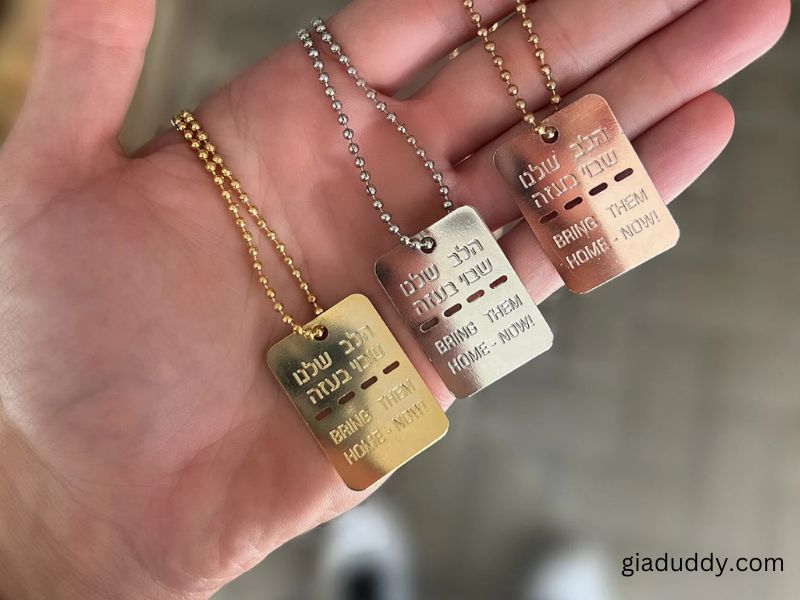Dog tags are an essential tool for ensuring your pet’s safety, providing crucial information for reuniting lost dogs with their owners. “Bring them home dog tags” represents more than just a piece of metal attached to a collar; it is a direct link to reuniting your furry friend with you. In this article, we’ll explore the significance of dog tags, how to choose the right one, and why it’s so important to ensure that your dog always has one.
What are Home Dog Tags?
Home dog tags are identification tags worn by dogs that typically contain essential contact details, such as the dog’s name and the owner’s phone number. They play a pivotal role in helping lost pets return home safely. These tags are often made from durable materials such as stainless steel, aluminum, or brass, designed to withstand wear and tear from daily activities.
Why Are Home Dog Tags Crucial?
The core function of dog tags is straightforward: they provide immediate identification and a means of contacting the dog’s owner. This is particularly important if a dog gets lost. While a microchip is a valuable backup identification tool, a dog tag offers a more immediate solution. A microchip requires scanning equipment to be detected, while a visible dog tag can immediately inform a stranger who finds the dog of who the owner is and how to contact them.
Dog tags are particularly important because they are often the first and sometimes only way a person can identify and contact the pet’s owner. When you lose a pet, every moment counts. A dog tag can significantly reduce the time your dog is lost, ensuring a quicker and safer reunion.
What Information Should You Include on a Home Dog Tag?
The information you include on your dog’s tag should be both sufficient and concise. At a minimum, a dog tag should have:
- Your dog’s name.
- Your phone number.
- Your address or city and state.
While adding additional information like the dog’s medical condition or indicating that the dog is microchipped can be helpful, space on smaller tags is limited. Be sure to prioritize the most critical contact information to ensure it is clearly legible.
If your dog is lost in a different state or city, a microchip can be a lifesaver, but an up-to-date dog tag ensures that someone who finds your dog can contact you immediately. In addition, many dog owners opt for tags with a note indicating “microchipped,” which adds another layer of security.
Choosing the Right Material for Dog Tags
When selecting a home dog tag, it’s important to consider the material it’s made of. Dog tags are typically crafted from:
- Stainless steel: Known for its strength and resistance to rust, making it ideal for active dogs.
- Brass: Offers a more classic and elegant look and engraves beautifully.
- Aluminum: Lightweight and affordable, though less durable than stainless steel.
The material you choose should depend on your dog’s activity level and the environment in which they spend time. If your dog loves to play in water or mud, stainless steel might be the best option for longevity.
Dog Tag Styles and Attachments
Dog tags come in various shapes and sizes. From traditional round designs to bone-shaped or custom tags, there’s a style for every dog. For small dogs, lightweight tags are preferred, while larger dogs may benefit from more robust designs. Choose a style that reflects your dog’s personality but also one that’s practical and comfortable for them to wear.
The attachment is also crucial. The ring or clip holding the tag should be secure enough to prevent it from falling off during play or exercise. Split rings are common but can sometimes come undone, so consider options like double rings or S-hooks for added security.
Why “Bring Them Home” Dog Tags Matter
The phrase “bring them home dog tags” encapsulates the fundamental role of these small but mighty identifiers. Whether you’re walking your dog in the park or traveling with them on vacation, a home dog tag is a simple yet essential tool to ensure they can be returned to you if they ever get lost.
In some cases, dogs wander off and are found in areas far from their homes, which can make it challenging to track them down. A well-designed dog tag can make the difference between a long search and a quick reunion. In addition to offering peace of mind, dog tags also help others to quickly identify the pet as someone’s companion, avoiding confusion with strays.
Customizing Your Dog Tag
While a dog tag’s primary function is identification, it’s also an opportunity for personalization. Many pet owners opt for custom dog tags with unique engravings, such as a favorite quote, the dog’s breed, or even a fun design. Adding these details can make the tag stand out and reflect your pet’s individuality.
You can also personalize the tag to match your contact information more precisely, such as adding an email address, an emergency contact, or additional notes that may be helpful in case your dog is found.
Replacing Your Dog Tags
Dog tags should be replaced if they become damaged or if the information is no longer legible. It’s important to check the tag regularly to ensure it hasn’t worn down, as legibility is key to effective communication in case of a lost dog. If your dog’s tag becomes noisy, you can also invest in a silencer to dampen the sound, making it more comfortable for both you and your pet
Conclusion
“Bring them home dog tags” are more than just accessories for your pet. They are essential for ensuring the safety and security of your dog, providing a reliable method of reuniting lost dogs with their families. When choosing a dog tag, consider the material, style, and the information that will be included. Customization options allow you to personalize your dog’s tag while ensuring that it serves its practical purpose.
Investing in a durable, well-engraved home dog tag is one of the simplest ways to protect your pet and provide peace of mind. Whether you are a first-time dog owner or have had pets for years, the importance of dog tags cannot be overstated. Always keep your contact information up to date, and make sure your dog’s tag is in good condition, ready to serve as a lifeline in an emergency.
FAQs
- What is the best material for dog tags?
Stainless steel is the most durable and rust-resistant, while brass offers a traditional look and aluminum is lightweight and affordable. - What should I put on my dog’s tag?
At a minimum, include your dog’s name and phone number. You can also add your city and state, and consider marking “microchipped.” - How often should I replace my dog’s tag?
Replace the tag when the engraving becomes illegible or if the tag is damaged. - Can I personalize my dog’s tag?
Yes! Custom engravings are widely available, allowing you to choose fonts, designs, and additional information. - Where can I buy home dog tags?
Pet stores, online retailers, and some veterinarians offer a wide selection of dog tags to suit your preferences.
By keeping these factors in mind, you’ll ensure that your dog has the best chance of coming back home quickly if they ever get lost.


